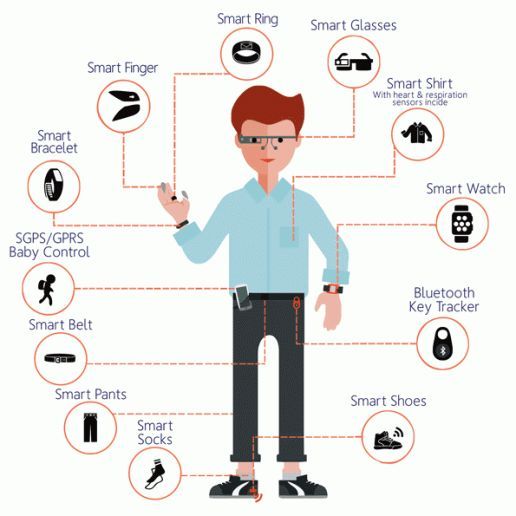In today’s fast-paced world, wearable technology has emerged as a transformative force, enhancing our daily lives in ways we never imagined. From smartwatches that monitor our health to fitness trackers that motivate us to stay active, wearable tech is revolutionizing how we interact with our environment and ourselves. This article delves into the fascinating realm of wearable devices, exploring their impact on health, fitness, and overall well-being, while also highlighting key trends and innovations shaping the future of this dynamic industry.
As you read on, you will discover how wearable technology is not just a trend but a vital component of modern living. We will examine the various types of devices available, their functionalities, and how they can help you achieve your personal health and fitness goals. Additionally, we will discuss the integration of wearable tech with smart home devices and the Internet of Things (IoT), creating a seamless ecosystem that enhances convenience and efficiency in our lives.
Moreover, we will address the potential challenges and privacy concerns associated with wearable technology, ensuring you are well-informed about both the benefits and the risks. By the end of this article, you will have a comprehensive understanding of how wearable tech is enhancing life and why it is essential to stay updated on the latest advancements. So, let’s dive into the world of wearable technology and explore the incredible ways it can enrich your life!
Health Monitoring and Fitness Tracking
Wearable technology has revolutionized the way individuals monitor their health and fitness. Devices such as smartwatches and fitness bands are equipped with sensors that track vital signs, including heart rate, blood pressure, and oxygen levels. This real-time data allows users to gain insights into their physical condition and make informed decisions about their health.
Moreover, fitness tracking features encourage users to stay active by setting goals and providing reminders. Many devices also offer personalized workout plans and track progress over time, making it easier for individuals to achieve their fitness objectives. The integration of health monitoring with mobile applications further enhances the user experience, allowing for detailed analysis and sharing of health data with healthcare professionals.
Enhanced Communication and Connectivity
Wearable devices have transformed communication by enabling users to stay connected without the need for smartphones. Smartwatches, for instance, allow users to receive calls, messages, and notifications directly on their wrists. This hands-free communication is particularly beneficial for individuals who are often on the go or engaged in activities where using a phone is impractical.
Additionally, many wearable devices support voice commands and integration with virtual assistants, making it easier to manage tasks and access information quickly. This seamless connectivity not only enhances productivity but also fosters a more connected lifestyle, allowing users to engage with their digital world effortlessly.
Sleep Tracking and Improvement
Quality sleep is essential for overall well-being, and wearable technology plays a significant role in helping individuals monitor and improve their sleep patterns. Many devices come equipped with sleep tracking features that analyze sleep duration, quality, and cycles. This data provides valuable insights into sleep habits, enabling users to identify factors that may be affecting their rest.
By understanding their sleep patterns, users can make necessary adjustments to their routines, such as establishing a consistent sleep schedule or creating a more conducive sleep environment. Some wearables even offer guided breathing exercises and relaxation techniques to promote better sleep, making them an essential tool for those seeking to enhance their nightly rest.
Safety and Emergency Features
Wearable technology has also made significant strides in enhancing personal safety. Many devices now include features such as fall detection, emergency SOS alerts, and location tracking. These functionalities are particularly beneficial for elderly individuals or those with medical conditions, providing peace of mind to both users and their families.
In the event of an emergency, wearables can automatically alert designated contacts or emergency services, ensuring timely assistance. This integration of safety features into everyday devices not only enhances individual security but also fosters a sense of community support, as users can feel more secure knowing help is just a button press away.
Fashion and Personalization
As wearable technology continues to evolve, the emphasis on style and personalization has become increasingly important. Manufacturers are now designing devices that not only offer functionality but also cater to individual tastes and preferences. From customizable watch faces to interchangeable bands, users can express their personal style while enjoying the benefits of wearable tech.
This focus on fashion has led to collaborations between tech companies and fashion brands, resulting in stylish wearables that appeal to a broader audience. As a result, wearable technology is no longer seen as merely functional but as a fashionable accessory that complements everyday attire.
Future Trends in Wearable Technology
The future of wearable technology is promising, with advancements in artificial intelligence, augmented reality, and health monitoring set to redefine the landscape. Emerging trends include the development of smart clothing that can monitor health metrics and provide real-time feedback, as well as augmented reality glasses that enhance everyday experiences.
As technology continues to advance, we can expect wearables to become even more integrated into our daily lives, offering innovative solutions for health, communication, and personal safety. The potential for wearable tech to enhance life is vast, making it an exciting field to watch in the coming years.
| Aspect | Description |
|---|---|
| Definition | Wearable technology refers to electronic devices that can be worn on the body, often incorporating sensors and software to collect data and provide insights. |
| Health Monitoring | Devices like smartwatches and fitness trackers monitor vital signs such as heart rate, sleep patterns, and physical activity, promoting better health management. |
| Fitness Tracking | Wearables help users track workouts, set fitness goals, and receive feedback, encouraging a more active lifestyle. |
| Safety Features | Some wearables include safety features like fall detection and emergency alerts, providing peace of mind for users and their families. |
| Convenience | Wearable devices allow users to receive notifications, control music, and access apps directly from their wrist, enhancing daily convenience. |
| Data Collection | Wearables collect vast amounts of data that can be analyzed to improve personal health and fitness strategies, as well as contribute to larger health studies. |
| Integration with Other Technologies | Wearable tech often integrates with smartphones and other smart devices, creating a seamless ecosystem for users. |
| Future Trends | Advancements in AI and machine learning are expected to enhance the capabilities of wearable devices, making them even more personalized and effective. |



